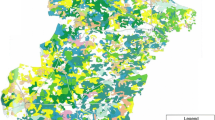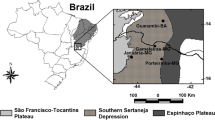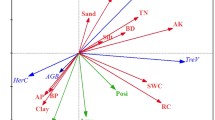Abstract
Aim
A further understanding of relationship between soil and vegetation is a prerequisite for accelerating vegetation restoration in karst area. Remarkable achievements have been made at regional and individual plant scales, but research on the relationship between soil and vegetation is insufficient at the hillslope catena scale in karst area.
Methods
Soils and vegetation were investigated along a toposequence of the dolomite peak-cluster depression catchment. Redundancy analysis (RDA) and structural equation modelling (SEM) were used to analysis topography, soil, and vegetation relationships.
Results
The dolomite rocks displayed an evenly progressive karstification process. This led to an undeveloped underground karstic network that was unable to transport soil materials into ground. Soil materials accumulated at different topographic positions and formed continuous catena. Soil types showed a gradual transition in the form of: Entisol--Inceptisol--Semi-alfisol--Alfisol. The vegetation communities also corresponded to the change of different soil types along the slope, showing a gradual transition of herbs--herbs and shrubs--shrubs and trees--herbs and trees. RDA analysis displayed that the fine soil mass ratio was an important influencing factor for vegetation. SEM demonstrated that slope gradient directly impacted on soil nutrient stocks and indirectly affected vegetation diversity.
Conclusions
A continuous soil catena pattern was developed along the toposequence. Parameters for nutrient stocks might be more suitable for assessing soil productivity and guiding vegetation restoration in karst regions than nutrient content parameters. Slope gradient, fine soil mass ratio and nutrient stocks were important factors affecting plant diversity in karst areas.










Similar content being viewed by others
References
Applegarth MT, Dahms DE (2001) Soil catenas of calcareous tills, Whiskey Basin, Wyoming, USA. Catena 42(1):17–38. https://doi.org/10.1016/S0341-8162(00)00116-8
Bai XY, Wang SJ (2011) Relationships between soil loss tolerance and karst rocky desertification. Journal of Natural Resources 26(8):1315–1322. https://doi.org/10.1016/S1671-2927(11)60313-1
Bao SD (2000) Soil agrochemical analysis, 3rd edn. China Agriculture Press, Beijing
Beven KJ, Kirkby MJ, Freer JE et al (2021) A history of topmodel. Hydrology and Earth System Sciences 25:527–549. https://doi.org/10.5194/hess-25-527-2021
Birkeland PW, Burke RM (1988) Soil catena chronosequences on eastern sierra-nevada moraines, california, USA. Arctic and Alpine Research 20:473–484. https://doi.org/10.2307/1551345
Boling AA, Tuong TP, Suganda H et al (2008) The effect of toposequence position on soil properties, hydrology, and yield of rainfed lowland rice in Southeast Asia. Field Crops Research 106:22–33. https://doi.org/10.1016/j.fcr.2007.10.013
Brunner AC, Park SJ, Ruecker GR et al (2004) Catenary soil development influencing erosion susceptibility along a hillslope in Uganda. Catena 58(1):1–22. https://doi.org/10.1016/j.catena.2004.02.001
Robinson DA, Abdu H, Jones SB et al (2008) Eco-geophysical imaging of watershed-scale soil patterns links with plant community spatial patterns. Vadose Zone Journal 7(4):1132–1138. https://doi.org/10.2136/vzj2008.0101
Deressa A, M. Yli-Halla, M. Mohamed, et al (2018) Soil classification of humid western ethiopia: a transect study along a toposequence in Didessa watershed. Catena 163: 184–195. doi: https://doi.org/10.1016/j.catena.2017.12.020.
Ford D, Williams PW (2015) Karst Hydrogeology and Geomorphology. Wiley
Ding YL, Nie YP, Chen HS et al (2021) Water uptake depth is coordinated with leaf water potential, water-use efficiency and drought vulnerability in karst vegetation. New Phytologist 229:1339–1353. https://doi.org/10.1111/nph.16971
Fei W, Qin F, Wu D et al (2015) Comparative study on the calculation method of soil organic matter and organic carbon. Journal of Agriculture 5(03):54–58
Feng T, Chen HS, Polyakov VO et al (2016) Soil erosion rates in two karst peak-cluster depression basins of northwest Guangxi, China: Comparison of the RUSLE model with (CS)-C-137 measurements. Geomorphology 253:217–224. https://doi.org/10.1016/j.geomorph.2015.10.013
Gilfillan S, Lollar BS, Holland G et al (2009) Solubility trapping in formation water as dominant CO2 sink in natural gas fields. Nature 458(7238):614–618. https://doi.org/10.1038/nature07852
Hao WU, Amp NA, University F et al (2015) The Relationship between Terrain Factors and Spatial Variability of Soil Nutrients for Pine-Oak Mixed Forest in Qinling Mountains[J]. Journal of Natural Resources 30(05):858–869
Hartmann A, Gleeson T, Wada Y et al (2017) Enhanced groundwater recharge rates and altered recharge sensitivity to climate variability through subsurface heterogeneity. Proceedings of the National Academy of Sciences of the United States of America 114:2842–2847. https://doi.org/10.1073/pnas.1614941114
Hong-Liang W, Wang SC, Sheng-Chang H et al (2018) Evolutionary characteristics of fertility and productivity of typical black soil in recent 30 years. Journal of Plant Nutrition and Fertilizers 24(6):1456–1464. https://doi.org/10.11674/zwyf.18238
Hongyan L, Zihan et al (2019) Rock crevices determine woody and herbaceous plant cover in the karst critical zone. Science China (Earth Sciences) 62(11):96–103. https://doi.org/10.1007/s11430-018-9328-3
Hu K, Chen H, Nie Y et al (2015) Seasonal recharge and mean residence times of soil and epikarst water in a small karst catchment of southwest China. Scientific Reports 5:10215. https://doi.org/10.1038/srep10215
Jiang Z (1999) Dynamics features of the epikarst zone and their significance in environments and resources. Acta Geosicientia Sinica 20(3):302–308. https://doi.org/10.3321/j.issn:1006-3021.1999.03.014
Jiang ZH et al (2020) Bedrock geochemistry influences vegetation growth by regulating the regolith water holding capacity. Nature communications 11:2392. https://doi.org/10.1038/s41467-020-16156-1
Jiang Z, Lian Y, Qin X (2014) Rocky desertification in Southwest China: Impacts, causes, and restoration. Earthence Reviews 132:1–12. https://doi.org/10.1016/j.earscirev.2014.01.005
Kikuchi T (1990) A DCA analysis of floristic variation of plant communities in relation to micro-landform variation in a hillside area. Ecological review 22(1):25–31. https://doi.org/10.2174/1567205011310040009
Li A, Duan X (2014) Productivity assessment for black soil region in northeastern china using black soil thickness a case study of hebei watershed. Bulletin of Soil and Water Conservation 34:154–159. https://doi.org/10.13961/j.cnki.stbctb.2014.01.044
Liu H, Jiang Z, Dai J et al (2019) Rock crevices determine woody and herbaceous plant cover in the karst critical zone. Science China Earth Sciences 62:1756–1763. https://doi.org/10.1007/s11430-018-9328-3
Lozano-García, B. and Parras-Alcántara, L (2014) Variation in soil organic carbon and nitrogen stocks along a toposequence in a traditional mediterranean olive grove. land degrad. develop 25: 297-304. doi: 10.1002/ldr.2284
Luo Y, Meng Q, Zhang J et al (2014) Species diversity and biomass in relation to soil properties of alpine meadows in the eastern Tibetan Plateau in different degradation stages. Journal of Glaciology and Geocryology 36(05):1298–1305
Nie Y (1994) Karst development characteristics under the lithologic control of carbonate rocks──a case study in south-central Guizhou. Carsologica sinica 01:31–36 (in Chinese)
Nie YP, Chen HS, Wang KL et al (2011) Seasonal water use patterns of woody species growing on the continuous dolostone outcrops and nearby thin soils in subtropical China. Plant & Soil 341(1-2):399–412. https://doi.org/10.1007/s11104-010-0653-2
Podwojewski P, Poulenard J, Nguyet ML et al (2011) Climate and vegetation determine soil organic matter status in an alpine inner-tropical soil catena in the Fan Si Pan Mountain. Vietnam. Catena 87(2):226–239. https://doi.org/10.1016/j.catena.2011.06.002
Qiaoyun Huang (2017) Soil science (2rd edn). China Agriculture Press, Beijing, pp289-230
Rastetter EB, Kwiatkowski BL, Le Dizès S et al (2004) The role of down-slope water and nutrient fluxes in the response of Arctic hill slopes to climate change. Biogeochemistry 69(1):37–62. https://doi.org/10.1023/B:BIOG.0000031035.52498.21
Schlichting, E (1970) Bodensystematik und Bodensoziologie. Journal of Plant Nutrition and Soil Science = Zeitschrift fuer Pflanzenernaehrung und Bodenkunde 127:1-9. doi: 10.1002/jpln.19701270102
Scotton M, Andreatta D (2021) Anti-erosion rehabilitation: Effects of revegetation method and site traits on introduced and native plant cover and richness [J]. Science of The Total Environment. https://doi.org/10.1016/j.scitotenv.2021.145915
Sommer M, Schlichting E (1997) Archetypes of catenas in respect to matter - A concept for structuring and grouping catenas. Geoderma 76:1–33. https://doi.org/10.1016/S0016-7061(96)00095-X
U.S. Department of Agriculture. (2015) Soil Survey Laboratory Information Manual - Soil Survey Investigations Report No. 45 (Version 2.0).
Wang JY, Yan XY, Gong W (2015) Effect of Long-Term Fertilization on Soil Productivity on the North China Plain. Pedosphere 25(3):450–458. https://doi.org/10.1016/S1002-0160(15)30012-6
Wang S, Yan Y, Zhiyong F et al (2021) Rainfall-runoff characteristics and their threshold behaviors on a karst hillslope in a peak-cluster depression region. Journal of Hydrology 605:127370. https://doi.org/10.1016/j.jhydrol.2021.127370
Wang X, Cai C, Li H et al (2017) Influence of rock fragments on bulk density and pore characteristics of purple soil in Three-gorge Reservoir area. Acta Pedologica Sinica 54(02):379–386. https://doi.org/10.11766/trxb201601050569
Williams PW (1983) The role of the subcutaneous zone in karst hydrology. Journal of Hydrology 61(1-3):45–67. https://doi.org/10.1016/0022-1694(83)90234-2
Worthington S, Davies GJ, Alexander EC (2016) Enhancement of bedrock permeability by weathering. Earth-Science Reviews 160:188–202. https://doi.org/10.1016/j.earscirev.2016.07.002
Wrb I (2006) World Reference Base for Soil Resources. A Framework for International Classification, Correlation and Communication. World Soil Resources Reports.
Yang Y (2005) Vegetation structure in relation to micro-landform in Tiantong National Forest Park, Zhejiang. China. Acta Ecologica Sinica 25(11):2830–2840. https://doi.org/10.1111/j.1440-1789.2005.00601.x
Acknowledgments
This study was supported by the National Natural Science Foundation of China (42077077, 41930866, 41671287), the Guangxi Natural Science Foundation of China (2020GXNSFAA297242) and the Central Guided Local Science and Technology Development Fund Project (ZY21195016). We thank Xing-Yu Ma for help during the vegetation survey.
Author information
Authors and Affiliations
Corresponding author
Additional information
Responsible Editor: Xinhua He.
Publisher’s note
Springer Nature remains neutral with regard to jurisdictional claims in published maps and institutional affiliations.
Supplementary Information
ESM 1
(DOCX 5082 kb)
Rights and permissions
About this article
Cite this article
Meng, Q., Wang, S., Fu, Z. et al. Soil types determine vegetation communities along a toposequence in a dolomite peak-cluster depression catchment. Plant Soil 475, 5–22 (2022). https://doi.org/10.1007/s11104-022-05308-5
Received:
Accepted:
Published:
Issue Date:
DOI: https://doi.org/10.1007/s11104-022-05308-5




